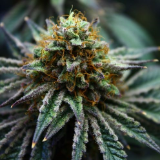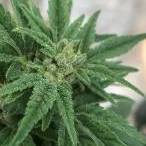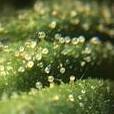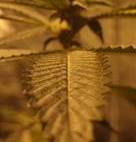Leaderboard
Popular Content
Showing content with the highest reputation on 10/05/2021 in all areas
-
INTRODUCTION: ROSIN 101 The best solventless extractions require the best cannabis for starting material. Whether it’s bubble hash, dry sift, or rosin, premium cannabis concentrates are derived from cannabis flowers of superior genetics grown in the ideal environment, and harvested at peak ripeness. The process of creating cannabis concentrates with solventless extraction methods (without the use of solvents like butane or CO2) amplifies the existing quality of the cannabis from which it’s derived. Solventless extraction isn’t magic, and it won’t transform mediocre cannabis into a remarkable concentrate. The starting material directly determines the end product. Therefore, cultivating, harvesting, and preparing exceptional cannabis is key to making exceptional solventless extractions. The two main categories of solventless cannabis extractions are rosin and hash. The two forms of hash include bubble hash and dry sift hash, both of which are composed mostly of trichome heads with very little plant material. Bubble hash is created using the ice water extraction method, while dry sift is created by sweeping dry cannabis material over a series of mesh screens. Rosin can be made using flower, bubble, or dry sift as starting material, and the resulting rosin is known as either flower rosin, bubble hash rosin (or simply hash rosin), or sift rosin. Flower rosin is the fastest and most straightforward concentrate to produce, while hash rosin is generally considered the highest quality. Making rosin begins with loading cannabis starting material inside nylon filter bags, pre-pressing it with an aluminum mold, enclosing it within a folded piece of parchment paper, and placing it between rosin press plates where heat and pressure can be applied. The press gives us the right amount of pressure needed to extract rosin, while the heated plates provide high temperatures needed to liquefy the cannabis trichomes that contain all of the therapeutic compounds we’re aiming to extract. Several types of presses and rosin press plates are used in a variety of configurations, from hydraulic to pneumatic presses with either caged or uncaged plate set ups. Even a hair straightener will work for pressing rosin! We’ll outline the specific heat and pressure settings applied to each type of starting material in this overview. Pre-press molds are often used to compress the starting material inside the rosin filter bags before extraction. The loaded rosin bags are placed inside a folded sheet of parchment paper, which catches and holds the rosin as it’s extracted between the heated press plates. The rosin is then collected from the parchment paper with a rosin stamp or dab tool. (1) What Equipment You Need To Press Rosin (2) How To Build Your Own Rosin Press (3) Can You Really Press Rosin with a Hair Straightener? (4) Rosin Press Temperature Guide (5) Rosin Press Pressure Guide (6) 3 Reasons Why You Need a Pre Press Mold (7) How To Pack Rosin Bags (8) Hydraulic vs Pneumatic Presses (9) Caged vs Uncaged Rosin Press Plates PLANT GENETICS The quality of cannabis starting material is the predominant influencer of the quality of solventless extract it will produce. Just as the quality of cannabis starting material determines the quality of solventless extractions, genetics play a critical role in the outcome of a cannabis grow. While there are other impactful variables such as garden environment, plant genetics are the foundation of a high quality harvest. Selecting genetics known for producing copious amounts of resin is a good starting point . Specifically, flowers with an abundance of capitate stalked trichomes are what we’re aiming to cultivate, and some cultivars (strains/genetics) tend to produce more than others. Choosing seeds or clones that contain these genetics is the first decision to make when planning your operation. (10) Best Cannabis Strains for Pressing Rosin (11) Which Cannabis Strains Are Best for Washing Bubble Hash? (12) Why Is Pheno-Hunting Important for Rosin? GROWING ENVIRONMENT The right genetics can only express their most spectacular traits if given an optimum environment in which to flourish. Whether it’s an indoor or outdoor grow space, factors like light, temperature, humidity, and nutrients will determine the outcome of the harvest. The best genetics placed in a subpar growing environment will never live up to their potential. Thoughtful design and configuration, intentional selection of equipment, and meticulous attention to detail are components of a quality garden. At the same time, nature knows what’s best. We are facilitating growth, not playing God. The idea is to create the best space for the cannabis plant to do its thing. (13) Cultivating Soil for Maximum Terpene Expression (14) Guide To Pressing Rosin for the Outdoor Grower (15) Do I Need To Grow My Own Cannabis To Press Rosin? HARVEST AT PEAK RIPENESS Good genetics placed in the ideal growing environment will produce resin-packed buds at harvest time. But how can you determine the best time to harvest your flowers? The answer lies in the trichomes. Those tiny translucent globes convey peak levels of ripeness based on their coloration, starting first as completely clear, then moving to milky and finally amber-colored . When the trichome heads are predominantly amber, this signals the peak of resin production and the height of therapeutic compounds within. Using a magnifier like a jeweler’s loupe is the best way to peer into the world of trichomes and gage maximum ripeness. (16) Guide To Trichomes and Solventless Extraction (17) How To Harvest Cannabis at Peak Trichome Ripeness FLOWER ROSIN, SIFT ROSIN, OR BUBBLE HASH ROSIN? Before harvest day it’s important to decide how you intend to use the flowers. Assuming that solventless extraction is the goal, you have a few different options. Flower rosin can be produced using air dried flowers and requires less processing than dry sift or bubble hash rosin. If flower rosin is the aim, you simply need to harvest and dry the flowers, then press them using heated rosin press plates. Flower rosin is a great option if you’re just getting started in rosin and want to learn the mechanics and general workflow, without having to first process the flowers into hash. If hash rosin is your objective, the harvested flowers need to be processed into hash, which is either dry sift or bubble (bubble hash being the more pure of the two types of hash). Dry sift hash is made by sweeping dried, trichome-rich cannabis material over a set of mesh sieving screens, employing the force of gravity to separate trichomes from the rest of the material. Bubble hash involves a bit more complexity than dry sift, and is made using a process called ice water extraction. Ice water extraction uses cold water and a liquid vortex to separate trichomes from the remaining plant material. Both flower rosin and dry sift rosin require dried cannabis flowers as starting material, so hanging cannabis to dry immediately after harvest is the way to go. Although dry sift hash needs to be made with dry cannabis material, bubble hash can be made with either dry or “fresh frozen” cannabis. Fresh frozen cannabis refers to material that’s been frozen immediately after harvest to preserve the best qualities of the living plant, such as terpene content. Fresh frozen material is only used in the production of bubble hash and bubble hash rosin. Rosin filter bags hold the cannabis starting material and provide filtration while heat and pressure are applied in between the rosin press plates. As the rosin is squeezed from the material it passes through the filter bags before oozing out onto the parchment paper. Unwanted material is contained within the rosin bags, while pure rosin flows through. (18) Top 3 Reasons Why Solventless Is Superior (19) Flower Rosin vs Hash Rosin (20) Average Rosin Yields from Various Cannabis Starting Material FLOWER ROSIN Drying Flowers for Flower Rosin If pressing flower rosin is your objective, drying your freshly-harvested crop is the first step . Wet cannabis can’t be pressed into rosin, so hanging the flowers upside down to dry anywhere from several days up to two weeks will bring the material to the proper moisture level. In preparation for rosin production, cannabis flowers should maintain 60-65% relative humidity (RH). The best way to monitor moisture levels is with a digital hygrometer and a glass mason jar. Place the buds and a digital hygrometer within a sealed mason jar, and wait until the reading stabilizes. If the buds are showing RH over 65% then keep drying. If under 60%, you can rehydrate the material in preparation for rosin production . (21) What Is the Best Environment for Hang Drying Cannabis Flowers? (22) How To Rehydrate Cannabis Flowers That Are Too Dry for Pressing Rosin Pressing Flower Rosin Once the buds have achieved optimum moisture content, it’s time to prep them for rosin production. Selecting the correct rosin filter bags and setting the correct temperature and pressure outputs at your rosin press plates are the leading variables of the process. 90-120 micron rosin filter bags provide the ideal filtration power for pressing flower rosin. Whole buds should be broken up into smaller, popcorn-sized pieces by hand, not ground into a powder with a grinder. Regardless of the starting material you’re using, the rosin filter bag should be packed tightly to avoid empty spaces and large gaps within the material. 180-210 degrees Fahrenheit at 650-1000 PSI is the recommended range for pressing flower rosin. Note that pressure readings on your rosin press may not be the amount of pressure that’s actually being applied to your starting material at the bag. Calculating Platen PSI for your specific set up will help ensure accuracy. (23) How To Find the Best Flower for Pressing Rosin (24) What Micron Do I Use? (25) How To Press Flower Rosin Starter Guide (26) Top 5 Rosin Pressing Tips for Flower (27) How To Calculate Platen PSI DRY SIFT ROSIN Making Dry Sift Hash Dry sift is a form of solventless cannabis concentrate that involves separating trichome heads from cannabis plant material and isolating them for collection using a set of mesh sieving screens. Resin-coated cannabis flower or trim leaf is whisked back and forth over a series of stackable screens composed of varying pore sizes. While plant material is contained on the upper screens, trichome heads are small enough to pass through for collection on the lower screens. Dry sift can be made using a steady, sweeping motion of your hands across the surface area of the screens, or with the help of a card (e.g. a credit card) to move and gently agitate the cannabis over the mesh filter. This technique is known as “carding”. (28) What Is Dry Sift? (29) The Ultimate Guide To Dry Sift Cleaning Dry Sift Hash with Static Tech Trichome heads that collect on top of sifting screens are often intermingled with a noticeable amount of tiny plant particles that also made their way through the mesh filter. The most desirable hash contains trichome heads exclusively, without the presence of other plant material. It’s difficult to remove plant material from dry sift hash, but it can be done with a technique known as Static Tech. There are various forms of static tech, but the basic principle involves the use of static electricity to separate trichomes from plant material in such a way that the trichomes can be collected and the remaining material can be discarded. Pressing Sift Rosin While dry sift can be consumed on its own, most extractors prefer to press dry sift into rosin. Hash rosin that’s been pressed from dry sift is called sift rosin, and it’s generally considered a step up in quality from flower rosin. As with pressing flower rosin, selecting the correct micron rosin filter bag plus temperature and pressure settings at the rosin press are the top variables to consider. Smaller micron rosin filter bags can accommodate dry sift, so 37-75 micron bags are generally suited for pressing sift, depending on the purity. In general, the more pure the source material you’re pressing, the smaller the micron size rosin bag you need. Double-bagging is also a good idea with pressing both sift and bubble hash rosin. The volume of rosin outflow from the sift and bubble hash is generally higher than that from flower rosin, and the additional reinforcement of a second bag helps to prevent blowouts. A larger micron such as 120 or 160 is often used as the outer bag, but the recommended 37-75 microns for sift will also work doubled-up. If using different microns, the larger micron should be on the outside. 140-200 degrees Fahrenheit with Platen PSI between 500-1500 are good ranges in which to experiment with sift rosin. BUBBLE HASH ROSIN Washing Bubble Hash Bubble hash is the highest quality of hash, known as bubble hash because of the small bubbles that appear on the surface when exposed to heat . Bubble hash is rated on a scale of one to six stars, 6-star hash being the most pure and highest-quality. 5 and 6-star hash is also known as full melt hash, because it will fully burn away and leave no waxes or residuals behind on a nail or bowl when smoked. Making bubble hash is often referred to as “washing” hash, and involves a process known as Ice Water Extraction . Cannabis material (either flowers or trichome-covered trim leaves) is mixed in a bucket with ice water, stirred together with a circular motion to create a vortex in the water. This vortex, coupled with the ice cold temperature of the water, allows the trichome heads to break away from their stalks. This slurry of ice water, plant material, and trichomes is then poured through a series of filter bags, also called Bubble Wash Bags, through which the trichomes heads are separated from the remaining material. While tap water is probably the most convenient water to obtain, it’s not the best. Use RO water when washing hash for the best results. Each wash bag in the series contains a different size of filter screen, ranging in pore size from 220 to 25 microns. The filters which most closely match the size of full trichome heads will collect the highest grades of hash. Filters larger than trichomes catch and hold plant material that can be removed from the batch, while filters smaller than trichomes catch lesser-qualities of hash containing trichome stalks, broken heads, and tiny pieces of plant material. After the ice hash water slurry is poured through the filters, the wash bags are removed from the work bucket one by one and gently scraped with a cold metal spoon for the hash that’s collected on the screen. 120, 90, 75, and 50 micron wash bags usually collect the purest hash, composed almost exclusively of trichome heads with minimal contamination. (30) The History of Bubble Hash (31) How To Wash Bubble Hash (32) Top 20 Best Tips for Washing Bubble Hash (33) Why Is RO Water Best for Washing Bubble Hash? (34) What Is the Purpose of Using Multiple Bubble Wash Bags? (35) Best Qualities for Bubble Wash Bags Drying Bubble Hash Drying the hash that’s collected from the wash bags is a critical step that can make or break the entire process . Wet hash invites microbial growth like mold, which will completely ruin the product, rendering it unusable. As the wet hash is scraped from the filter screens, the trichome heads stick together in an amorphous glob, somewhat resembling a loose and extremely wet pancake batter. This patty of hash can be dried using various methods, the most effective of which is freeze drying. Freeze drying utilizes the process of sublimation coupled with a vacuum chamber to quickly and thoroughly dry the hash with minimal exposure to oxygen. Freeze dryers are advanced pieces of equipment that are often used by commercial processors. The cost of freeze dryers can be prohibitive to in-home extractors and casual hobbyists. It just depends on your budget! Air drying hash is a fine alternative to freeze drying. To air dry hash, immediately freeze the wet hash patty for 24 hours, or until it’s frozen into a solid block. Then take the frozen blob of hash and rub it back and forth across a kitchen sieve or strainer, which breaks the hash into smaller pieces. The resulting is a coarse powder or sand-like consistency in the hash, allowing it to dry out evenly. Without breaking the hash down into smaller pieces like this, moisture will get stuck inside the middle of the hash patty and harbor microbial growth. Sieve the wet hash over a piece of cardboard lined with parchment paper, and allow it to air dry in a cool, dry, dark space, or inside a refrigerator, until it’s completely dry to the touch. This can take a week or more. Squeeze a piece of the hash and feel for any moisture on your fingertips. When no moisture is present, the bubble hash is ready to go. (36) Best Ways To Dry Bubble Hash (37) How Does a Freeze Dryer Work? Pressing Bubble Hash Rosin 3 and 4-star hash is ideal for pressing into rosin. 1 and 2-star is better suited for edibles, and 5 and 5-star can be dabbed as it is. 25-37 microns is the recommended filter size for rosin bags when pressing bubble hash. Bubble hash is loaded into the rosin bags the same way as sift and flower, packed tightly to eliminate empty pockets within the material, but not so tightly that rosin cannot flow out from the center. It should feel dense and very compressed when squeezed between the fingers. For both flower, sift, and bubble hash, pre-press molds help to further compact and prime the material for extraction. As with dry sift, double-bagging for bubble hash is helpful in preventing blowouts due to the high volume of rosin that flows quickly from the hash under heat and pressure. A larger micron such as 120 or 160 is often used as the outer bag, but the recommended 25-37 microns for sift will also work doubled-up. If using different microns, the larger micron should be on the outside. 160-190 degrees Fahrenheit with Platen PSI between 350-750 are good ranges in which to experiment with bubble hash rosin. And with any type of rosin extraction, be sure to start with a lower PSI and gradually increase to full pressure over time . (38) How Hash Is Rated (39) Top 10 Hash Rosin Pressing Tips CURING ROSIN Rosin is ready to consume immediately after production, but a curing process can help enhance the flavor and stabilize consistency. Curing rosin involves the use of an airtight glass jar, such as a mason jar. This approach to curing rosin is known as Jar Tech, and there are two types of Jar Tech: Warm Curing and Cold Curing. Warm Curing involves exposing the rosin to temperatures anywhere between 90 and 135 degrees Fahrenheit. This can be accomplished in an oven, or even with a heating mat similar to what is used for warming cannabis cuttings. Cold curing is often done at cool room temperatures, in the 60-degree Fahrenheit range. Cold curing often preserves more of the volatile terpenes in rosin than warm curing. With both types of curing, keeping the lid sealed for the duration prevents terpenes from evaporating into the air. The lid can be “burped” intermittently during the cure, and some extractors like to “whip” the rosin as well. Terpenes often separate out naturally during the cure, and whipping helps to reintegrate the liquid terpenes back into the rosin. (40) How To Jar Tech Rosin (41) Cold Curing vs Warm Curing Rosin (42) Top 10 Warm Curing Rosin Tips (43) Top 10 Cold Curing Rosin Tips (44) What Are the Benefits of Whipping Rosin? STORING ROSIN Rosin can be stored for many months in glass containers with an airtight seal. Using glass to store rosin is key, since glass doesn’t interact with terpenes in the way that plastic or silicone does. Both plastic and silicone as susceptible flake away and leach into the rosin over time, as terpenes are actually a natural form of solvents. To preserve the natural state of the rosin, be sure to only store it in glass for the long term. Store rosin in a cool, dark, and dry environment. If storing in the refrigerator or freezer, be sure to allow the jar to come to room temperature when removing for use first before cracking open the lid. And wipe away any condensation that forms inside the glass, in order to prevent moisture from getting into the rosin. Bubble hash and sift can be stored following these same principles. Bubble Hash can also be heated and rolled into a Temple Ball for long term storage and aging. (45) How To Properly Store Rosin (46) What Is a Bubble Hash Temple Ball? (47) What Is the Purpose of Aging Bubble Hash? CONSUMING ROSIN Rosin is most commonly dabbed with a dab rig and heated nail or bowl. To optimize for the most flavorful smoke, use lower temperatures at the nail. If you prefer the ease and convenience of vape pens, rosin can be used to make vape cartridges. This requires extra steps to decrease the viscosity of rosin, but it can be done. Rosin can also be used for making edibles or other infusions, like MCT Oil capsules. You can even add rosin to joints for enhanced flavor and potency. (48) How To dab Rosin (49) How To Make Vape Cartridges with Your Rosin (50) Best Ways to Use Rosin CONCLUSION Unlike cannabis concentrates that utilize solvents for production (e.g. CO2 in closed-loop systems), solventless extracts like bubble hash and rosin are safe and easy to produce right from home, with minimal investment in equipment and starting material. Growing your own cannabis allows you to produce quality starting material and is often the most economical way to create a steady flow of top shelf cannabis concentrates. Solventless concentrates capture the essence of the plants from which they’re produced, delivering a pure, potent, and flavorful experience. Getting started is the hardest part. Once you start gaining some hands-on experience, you’ll quickly learn as you go and improve your process and your results. Take good notes along the way, learning from both your successes and so-called failures. What are you waiting for? Start your solventless journey and start rosin pressing today! Reference3 points
-
2 points
-
I take this as confirmation that mother-nature has accepted my plants into her domain and blessed this grow with good luck2 points
-
This is an unknown clone that made it into my room. It is mislabeled but I suspect it is Lost Coast OG or some type of chemdog cross. Here she is at 8 weeks2 points
-
I often let my plants go until there is some amber, I am not the biggest fan of cloudy and clear trichs and I find majority of smokers also prefer some amber as it seems as lot of people get anxiety when smoking and bud which has not had a chance to ripen leads to more paranoia and anxiety. A sweet spot between the two I think is ideal for majority of people. Too much amber and it can become a bit too couch lock and too soon with not enough amber and it either does not feel as strong or the side effects can become a bit much and unpleasant. Not to mention if you smoke at night, the lack of amber can disrupt your REM sleep and you wake up feeling groggy and tired still.2 points
-
late harvest (mostly amber trichs) - CBD/CBN rich, few more medicinal properties, hit's the body rather than the mind, longer lasting high, couch lock, sleep inducing. early harvest (mostly clear trichs) - hits the mind rather than the body, can cause a speedy feeling inducing anxiety and paranoia, high is short lasting. both are "intense" for different reasons, I like early harvest too cause I am already lazy as it is2 points
-
Hello bud, The plants are looking good, all looks pretty normal to me. Plants are very similar to humans in that from a very young phase are quite fragile in their infancy and then spring up into their adolescence getting stronger, healthier and hardier all the way through their mid life. Then once flowering comes along, during the middle or so, there is a noticeable decline in health and this is all normal everyone gets old. If you have only fed worm casting, you have given the soil more than anything, a workforce to make nutrients more available, I would definitely hold back on the worm casting for the remainder of the grow. The plants are fading back so the colour will completely leave the leaf and appear yellow until they fall, again very normal. Then you seems to be about halfway through flowering. Quite important to note the following as everything will be impacted by this, What soil are you using? There could be things the plant requires as your finish, or they might already be available and nature is taking its course in which case water will do, maybe some Aminos, humic/fulvic, Kelpak will be a great add, high potassium molasses weekly too, but tiny amounts will do the best job. Again the type of soil matters the most. Using synthetics in a thriving organic medium needs to be done with the utmost care and precision, I would advise against it as your plants look right on track.2 points
-
Yep! No doubt there anymore. The other 2 have also shown to have some serious balls . Totally explains their willingness to adapt and overcome, they pushed through all they had against them. Will be sad giving them the good 'ol snipping. In other news, day 2 of Flower, I'm itching to see the fruits of my labour! They are growing like mad now, loving the extra light and fancy new nutrients. @Prom, I took the dive and got some of that Bio-Heaven. Also got some Top Max today to start adding. Super excited about the next few weeks!2 points
-
@Green Leaf Organics that image is very unique. Creates a perfect feel for your setup. Lekker man2 points
-
Hi i am new to cannabis growing (2 years) and wanted to say Hi to all. Happy to be on this platform. ONE LOVE1 point
-
We're about 1 month into the grow now so here's a proper update on each plant: Dinamed 1: Growth has been slow for the past few weeks, likely because I planted to early, but it seems she's really kicked into gear over the last week (but she's still tiny). For the past two waterings I have included some Bio-Grow at (1.25ml per 2l), and she seems to be appreciating it. As you can see I've also kicked off LST today but I don't really know what I'm doing so I'm taking it super slow. Coincidently I noticed the first tiny pistol earlier so she's starting to flower - right on schedule, though I hoped she'd be a bit bigger by now. Think I'll start adding Bio-Bloom in a week or so. Dinamed 2: This seedling was planted at the same time as the one above, but had an issue with the first two leaves growing deformed. They eventually fell off and since then a bunch of little leaves have tried to grow. It's really hard to see in this photo but all the leaves are tiny and deformed. My current theory is that this plant has some kind of detrimental mutation preventing proper leaf development. Sad to say it but I've given up on her and already have a replacement germinating. Cheese 1: This plant is coming along similarly well to the Dinamed 1, but is just a little smaller. I have her on the same feeding schedule which includes Bio-Grow (at 1.25ml per 2l) for the last two waterings. LST was also started today - taking it very slow. Unlike Dinamed 1, this one shows no signs of flowering yet. Cheese 2: The initial seed didn't germinate, so this replacement was planted about a week after the others. Seems to be coming along well. I suspect she'll start growing more vigorously like the others shortly. I haven't given any fertiliser yet but will start with a low concentration at next watering. In other news, I've purchased a Wedryer XL to hopefully make the drying process as pain (and smell) free as possible. Also bought some Bio-Bizz Top Max which I'll add to feeding regime for plants in flowering phase. Oh, and two more FF 10l fabric pots.. It's quite crazy how slow the soil in plastic pots dries out compared to fabric.1 point
-
1 point
-
1 point
-
Yip like everyone mentioned, your plants look good But as @Batistamention, those leaves look abit dark green with slight clawing which points to too much nitrogen1 point
-
Hey Guys, This is only my second grow, please bear with me as I have tonnes to learn. My plants have been doing well up until the last week or so. In the last few days I observed quite a bit of leaf loss, and the plant appears to be droopy and unhappy. I suspect that overwatering may be the culprit, however, I have been leaving the plant to dry out before watering again. I generally water when the pots are light, but upon returning from a trip a week ago i noticed that the plants really needed water. Ever since then it has been downhill. I grow indoors, with a 240W Kingbrite Light. All plants are the same strain (Gorilla Glue #4), and are in 12L fabric pots. Over the last week i had to remove many brown/dead leaves, and the plant overall just does not look as good as it did, the buds also seem to have not changed a whole lot since then. I have also not fed any synthetic nutrients this time around, only top-fed worm castings thrice throughout the grow. Additionally, the plants are in organic living soil. I generally PH my water between 6 and 7, but about a month ago my PH pen broke. From experience, my water generally hovers around ph 7.5-8, and two tiny drops of ph down would do the trick. It has been this way since i started this grow a few months back, so i have been preparing the water in the same way until i get a new ph pen. I hope that one of you veteran growers would be able to diagnose what the issue is, if there even is an issue at all. I know they are on their final stretch, seems to be about 3 weeks to go, hence the excessive stress on my part. I hope i have provided enough information, if no please let me know. Any help would be greatly appreciated!1 point
-
Your plants look healthy and happy, there is a little bit of cupping in the last picture and possible slight clawing but nothing major. When last did you top dress with worm castings? For interest sake, what are the temps and RH in the tent on average?1 point
-
This makes sense I guess, I was hoping the temp controllers would try and counter this to keep the temp steady and stable. I have noticed the same on other dry herb vapes too though. Nothing new or specific to the IQ2. Also noticed it on a convection dry herb vape. I guess it is just heat soak of sorts, heating up other parts of the device as time goes on and just an overall slight increase in temp. Really not the end of the world, was wondering if it was just me or not.1 point
-
Yeah, based on trichomes looks as if they could go a bit longer. The haze is a sativa which generally can take longer to flower. When I grew Ghost Train Haze I think I flowered for 15 weeks and it could still have gone on for longer to get more amber and cloudy trichomes in there... I was just tired of keeping the plant in flower. Also did you have any issues with pests? The first photo looks as if the plant was attacked by some pests as the leaves look as if they have some spots on them.1 point
-
i also have it like that but at 3% amber.. just thinking, i dont want to count to 100 to get 3 .. so 1 out of 10 sounds better, lol.. but look at the pictures i took with a usb microscope above. after 12 weeks i still dont see any milky tricomes even, never mind amber...1 point
-
@Green Leaf Organics, I first saw this picture and thought this had to be the winner. Great pic! Congrats @Pantson 2nd! Another eye catcher in the posts for sure1 point
-
I have only been adding worm castings as top soil feed. I thought it had all-round nutrients. I do have synthetic nutes so I will give them a boost of bloom nutes when they're thirsty again. I will shop around for the PH pen, and will be sure to check communica as well. Thanks for the advice!1 point
-
Howdy, Looking good but there are some things to tackle. Nitrogen only source of fertiliser in the flowering phase is a general no no and is the reason why the buds are not fattening up and looking pointy. I also made this error when I tried organic and have now switched to fully synthetic and am happy with it. Are you using anything to provide a source of k? You also need to get a Ph pen because after each watering and application of amendments the Ph will swing and can't be corrected from memory after a few weeks of this. I recently went through having to replace a Ph pen and had one shipped to me from communica. Coza- found that to be the cheapest at that time. Sent from my SM-A715F using Tapatalk1 point
-
Yes I' do in fact... That will happen with conduction vapes more so, as the longer the oven is at that set temperature, the long it has to conduct and deeper it penetrates. More so over the convection as it's the same temp, only going over the oven, when pulled on. Smart path, na thank you. 190 to 195 spot on, depending on Terps and strains You can always vape it higher after, or just vape it longer at lower temps. Flavor over high for me1 point
-
Congratulations both of you, top notch photos By everyone actually1 point
-
Whoop whoop. Thanks all. Believe it or not this will be my first bong, after 25 years of toking. [emoji119] An update on how she finished, strain is hopefully 3 blue kings, gifted clone. 8 months of growing. Sent from my iPhone using Tapatalk1 point
-
We finally have our winners decided! In 2nd Place @Pants . 1st Place @Green Leaf Organics Well done guys! Will be giving you a shout by PM1 point
-
1 point
-
Spot on. If its on the leaves, then it needs more time. If that is on the bud itself, the calyx then you could cut. Leaving it to ripe more comes down to personal preference. Always take the flowering times with a teaspoon of salt. Personal preference comes into play as does phenotype and how quickly it ripens.1 point
-
They are in 30L at the moment but will be going up to 80L and 200L in about 2/3 weeks1 point
-
1 point
-
1 point
-
1 point
-
1 point
-
1 point
-
The plants have moved outside for good - with some added support to counter the strong winds. Some close ups of how they have been tied up - adjustable and avoid strangling the plant, leaving space for it to grow. This, repeated from different angles to get a stable core.1 point
-
They will reveg and you will have nice big plants , looks like balls yes but let's wait for the growers that know there balls Sent from my Hisense Infinity H50 using Tapatalk1 point
-
Week 6 done and start of week 7 This will be my last update until week 3 of flower. Everything has been boring up until now lol OK so we have seen the organics with some fast growth and they look lovely but the big question is, where the hell are the pics of the synthetic Marzcanna!? Well I don't like synthetic that's why lol! Actually the reason why I haven't posted any pics is because before I started this grow I had just enough amended coco from my previous grow for my organics, laziness soon kicked in when I realized that I'd have to buy anther brick, wash and buffered it, so I went and bought "washed and buffered" coco with perlite instead. Now I have mentioned that you should still wash and buffer your coco regardless and guess what I didn't follow my own advise, I watered the coco and planted directly (I won't mention the brand of the coco or the company, because it's partially my fault for not washing and buffering it regardless if it was advertised that it was) long story short you can guess what happen next, slow growth, alot of yellowing and even after loads of flushing and dosage of cal - mag it took the synthetics along time to recover (this is why I prefer to mix my own soil and this will be the last time I buy in pre made coco or mixed soil) The synthetics are now looking healthy and growing fast but I doubt it will catch up with the organics , I will post some pics soon but I guess it has thrown off the all side by side I had planed for this grow but forward we go. Here's a pic of the grow room at this stage and happy heritage day growmies!1 point
-
Okay this grow has turned into a soil grow:P The chiller didnt work and the plants were starting to shit themselves. So dismantled the system last night put into freedom farms soil, so will try again after this grow.0 points
This leaderboard is set to Johannesburg/GMT+02:00





.thumb.jpg.e58f50c1786850f985aef8f22a6f87f3.jpg)













